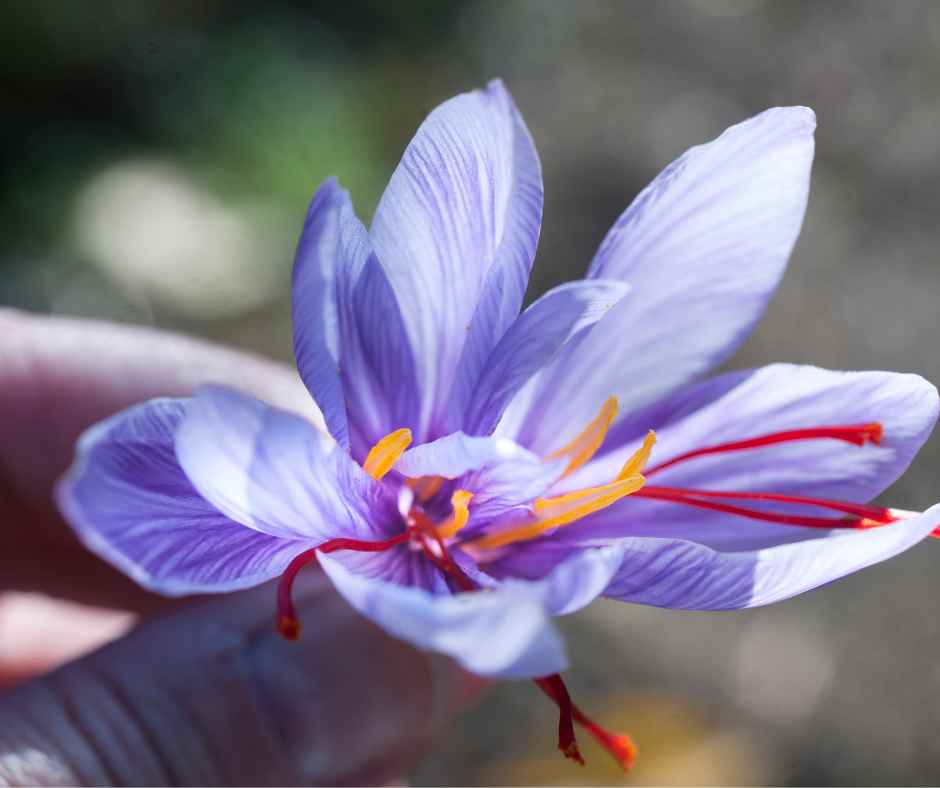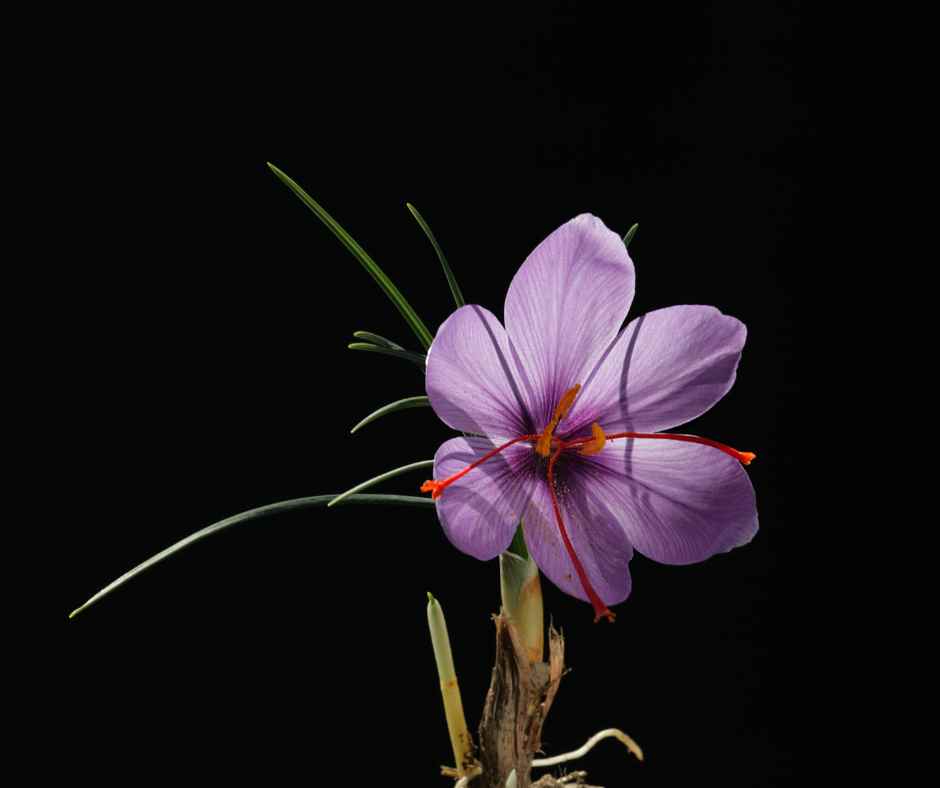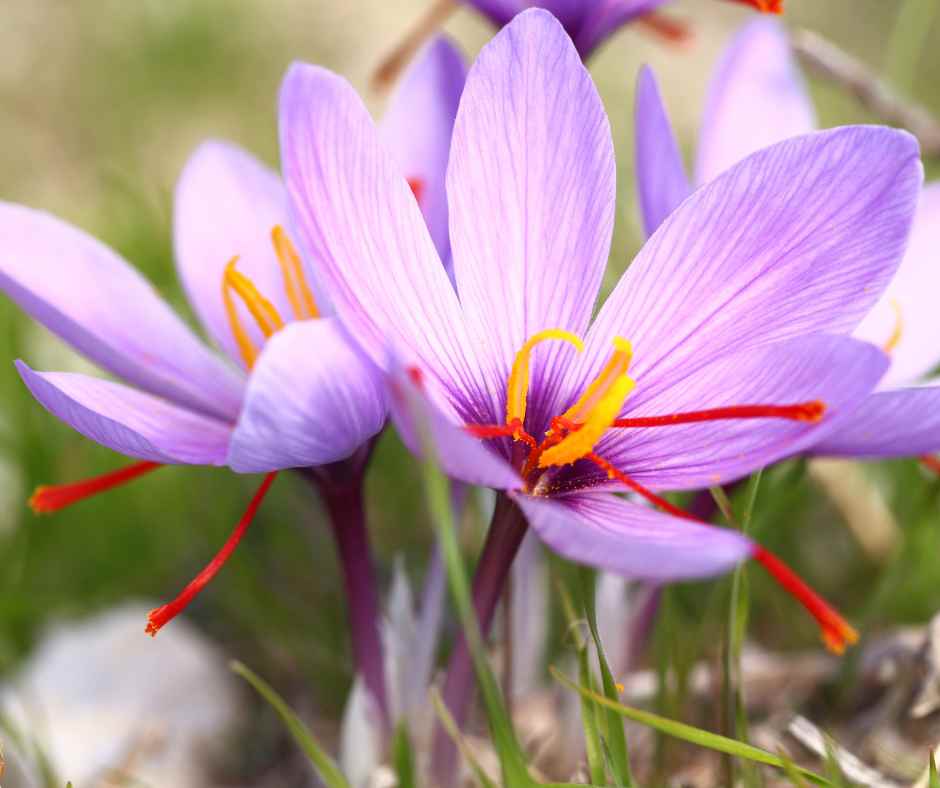When coming for gardening, people go for plants that are important, rare, and most beneficial. One of these plants is saffron. Saffron is a very expensive spice that can be planted easily, with proper care and patience.

As coming to vegetables and spices people do come for saffron. Because of its great nature, and the difficulty to find people who like to grow it in their settings, that’s why we are going to tell you how to grow saffron.
Saffron plants
Saffron is a spice derived from the flower of the saffron crocus. It is known for its distinct red color and strong, pungent flavor and aroma. It is used to flavor and color food and is also used in traditional medicine. Due to the labor-intensive process of harvesting saffron, it is one of the most expensive spices in the world.
Characteristics of the Saffron
Special Aroma
Saffron has a unique, pungent aroma that is easily recognizable. That’s why it is used as a spice as well.
Red color
Saffron is known for its deep red color, which is often used as a natural dye in food and textiles. That’s why it is quite expensive.
Use in kitchen
Saffron is a popular spice used in a variety of dishes, particularly in Mediterranean and Middle Eastern cuisines. It creates a unique taste and aroma.
Usage as medicine
Saffron is used in traditional medicine for its alleged anti-inflammatory and antidepressant properties. That’s why it is always in high demand.
Higher labor costs
Saffron is considered one of the most expensive spices in the world due to the amount of labor required to harvest it. It is a very expensive process to do.
Improvement in the soil
Saffron crocus can help in the improvement of soil quality. It helps in avoiding soil erosion and increases fertility by adding organic matter. That’s why people prefer this spice along with other medical and culinary benefits.
Pest control
As saffron is a perennial crop, it can be used as a companion crop to help control pests and diseases in other crops. It helps in repelling the pests from the settings where it has been planted.
Cautions before planting the saffron
Saffron is a delicate crop that requires specific growing conditions. The following are some of the important prerequisites to follow for planting saffron:
Choose well-draining soil for Saffron
Saffron requires well-drained soil that is rich in organic matter. The pH of the soil should be between 6.0 and 8.0. Higher levels of water may cause waterlogging.
Provide Adequate sunlight
Saffron needs full sun to grow. You need to choose an area that receives at least 6-8 hours of sunlight per day for the plantation of saffron. This helps in the healthy growth of saffron.
Choose Cooler temperatures for Saffron
Saffron prefers cool temperatures and can tolerate frost. The ideal temperature range for saffron is between 45-65°F. this will ensure good growth of saffron plants.
Go for Low humidity
Saffron does not tolerate high humidity and should be planted in an area with low humidity. So choose wisely.
Space properly
Saffron corms should be planted at a space of about 4-6 inches apart. This will make sure that the plant grows and spreads well without any hindrance from companion plants.
It’s also important to note that saffron is propagated from corms, which are underground storage structures. Corms should be planted in the fall, and it will take about 2-3 years for the corms to reach maturity and produce flowers.
Steps to grow saffron

Choose a sunny location with well-drained soil for planting saffron. The soil should have a pH between 6.0 and 8.0. The low drainage soil might cause problems for the growth of the saffron plants.
Saffron corms (bulbs) are typically planted in the fall, about 4-6 weeks before the first expected frost. You can get the bulbs easily from the local garden store, or you can order these corms from the internet but a trusted source.
Dig holes about 3-4 inches deep and 6 inches apart. Place a corm in each hole with the pointed end facing up. It will make sure the root ball has good space when the germination and growth will go on. Cover the corms with soil and firm it down gently. Water the area well after planting.
Saffron needs a period of cold treatment before the corms will sprout, so it is important to mulch the planting bed to help protect the corms from freezing temperatures. This will also keep the area moist, so you will not have to water it, again and again, to keep up the moisture.
Saffron crocus bulbs typically take 6-8 weeks to sprout, and it will take 2-3 years for them to reach maturity and start producing flowers. Saffron corms should be dug up and divided every 3-4 years to maintain their health and productivity. It will also multiply the number of saffron plans.
Taking care of saffron plants
Taking care of saffron plants demands care and attention. That’s why we are here to mention the important steps and actions to follow to get good growth of saffron plants.
Watering schedule
Saffron plants prefer consistently moist soil, but they should not be waterlogged. Water the plants when the soil is dry to the touch, but be careful not to over-water. The moisture will help the continuous growth of the saffron plants.
Fertilizers requirements for Saffron
Saffron plants should be fertilized every 3-5 weeks with a balanced fertilizer. A fertilizer with a ratio of 10-10-10 (NPK) is recommended, or you can use a fertilizer specifically formulated for bulb plants. This will help in the steady growth of the saffron plants.
Pests of saffron plants
Saffron plants are relatively pest-free, as they repel the pests but they can be attacked by aphids, slugs, and snails. These pests can be controlled with insecticides or by hand-picking them from the plants.
Diseases of saffron plants
Saffron plants are susceptible to a few diseases such as Fusarium oxysporum and Sclerotium cepivorum. These diseases can be controlled by using a fungicide, providing good drainage, and avoiding overcrowding of plants.
Additionally, it is also important to avoid working with the plants when they are wet and to remove and destroy any infected parts of the plant. This will help in decreasing the risk of saffron pants being attacked by such diseases.
It is also important to practice good sanitation, such as removing any debris or dead plants to prevent the spread of disease. Most of the time the saffron plants go well on their own. Also, the random companion planting might cause these diseases transferred to the saffron plants.
Harvesting of saffron

The process of harvesting saffron involves some careful steps. Some of the important ones are as follows:
The saffron crocus flowers are hand-picked early in the morning when the weather is dry and the flowers are fully open. Each flower has three stigmas, which are part of the flower that is used to make saffron. So look for these stigmas while harvesting.
The stigmas are carefully plucked from the flowers and dried. The dried stigmas are then packaged and sold as saffron. So handle these stigmas with care.
It’s important to note that saffron is a labor-intensive crop and the process of harvesting it is done by hand. It takes around 150 flowers to produce one gram of saffron, and each flower has only three stigmas. Due to this, saffron is one of the most expensive spices in the world.
Storage of saffron (as a spice/final product)
Saffron should be stored in an airtight container in a cool, dark place. This will help to preserve the color and flavor of the saffron. It’s also important to keep saffron away from light, as light can cause the color and flavor to fade. So store it in a dark place.
To maintain its quality and potency, saffron is best stored at room temperature, away from direct sunlight and moisture. Avoid storing saffron in the refrigerator, as the cool and humid environment can cause the spice to lose its potency and flavor more quickly.
You should also use saffron within one year of storage. The potency of saffron decreases over time, so it’s best to use it as soon as possible after purchasing it. It’s also important to note that saffron should be stored separately from other spices, as it can easily absorb the flavors of other spices and change its flavor profile.
You can sell the saffron easily if you more than you need, or you want to use fresh always. Due to its importance, you would be able to find the customer in your surroundings, as well as on commercial and online platforms.
In a nutshell, saffron is such a blessing of nature that it can’t be taken for granted. Once you have jumped into the process of growing the saffron you will have to complete it. It is because it is such a rewarding plant, that it will balance all the effort you have put into this whole process.

